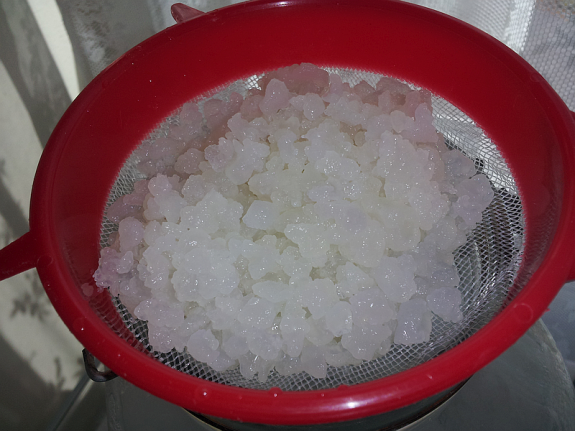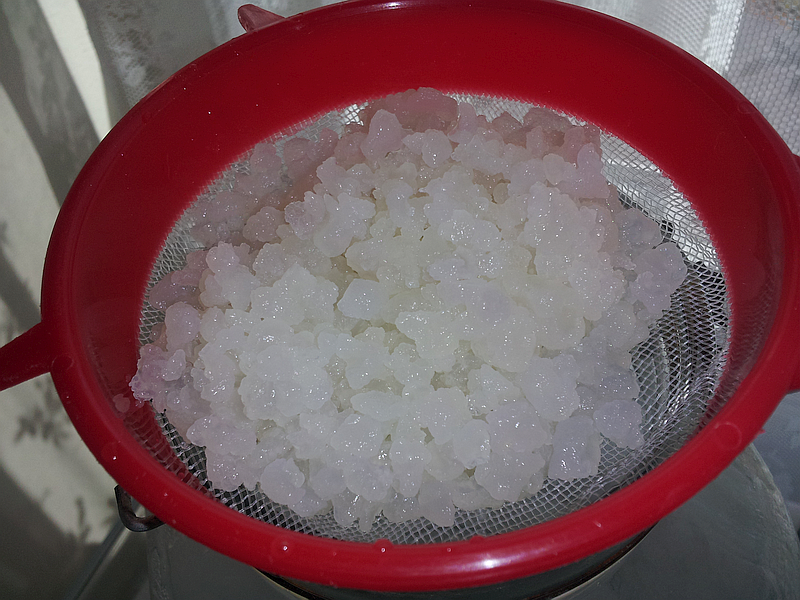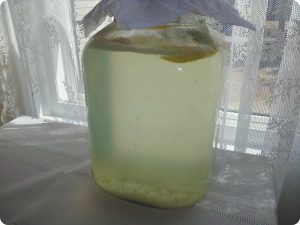Growing your own water kefir grains is not difficult, if you are careful, and you tend them properly you can make huge quantities of tibicos, the water kefir grains. You need a few tibicos as a starter, quality water, sugar, and some various fruits. To improve the process, you may also add minerals to your water.
Tibicos, or water kefir grains, the more popular name, are microorganisms colonies encapsulated in a polyssacharide shell, with a white translucid aspect. The colonies are formed from various bacteria and yeasts, and they live in a symbiotic relationship, helping each-other thrive. You cannot make the tibicos from scratch, you need at least one viable grain of the proper microbial combination as a starter. If you are a microbiologist, and have a lot of time in your hands, you could probably do it, but it’s way more effective to get a starter from someone.
The main food of the sugar kefir grains, (yet another name), is, you guessed it, sugar. They eat sugar in any form, but the cheapest sugar to use is regular refined sugar. However, they will consume any type of sugar, from stevia, (0 calories and safe for diabetics’ consumption), to fructose, and sugar-alcohols like xylithol. Some sugars like xylithol will have an impact on the colony’s balance and composition, due to the fact that xylithol is a bactericide. But fruit juices, stevia, refined and unrefined sugar, agave nectar, and anything else should be good as a food.
Where To Get Water Kefir
You can get water kefir from a friend, if theirs multiplied properly, or you can buy it from reputable seller. Taking it from a friend is the easiest and cheapest solution, however, this might not always be the best solution. Tibicos are relatively stable and they will kill any bacteria or yeast intruder, that is not in the original culture. However, sometimes opportunistic bacteria can infiltrate in the micro-environment and change the perfect probiotic balance. The soda made with these tibicos will still work as a probiotic, but it won’t be as effective as the original one, or it will cause side effects.
The best way is to use kefir grains from a reputable seller, that tends their cultures properly and don’t allow them to get contaminated by opportunistic yeast and bacteria. When you buy them, you usually buy them dried, and then you rehidrate them. Due to this process it might take up to four weeks until your grains will start to grow. Have patience, it is the best way to do it.
What To Feed Water Kefir Grains
As I shown earlier on this page water kefir grains can be fed almost anything that contains sugar. However, not all sugars will make them grow and multiply properly. In order to make the grains grow, you need to feed them properly at the first fermentation. I found that if you regularly feed them refined sugar, they will still grow, but it won’t be as fast as they can grow. So the key is to give them some unrefined sugar such as Sucanat, or Rapadura, or Panela. The unrefined sugar contains many minerals, which are normally stripped down from the refined white sugar.
Another trick is to give your little guys some trace minerals at the fermentation time, regardless of the sugar used. A great source is ConcenTrace, just add a dash to your gallon of soda. Some of the minerals will be used by the cultures, and some will remain in your soda, and you will drink it. Some people put a half of eggshell in the fermentation jar, and this will give your tibicos enough minerals. Other mineral sources can be: dash of unrefined sea salt or baking soda. Do not put too much eggshell in the jar, I found out that it slows down the fermentation. Although I didn’t try it, I assume that any mineral source will slow down the fermentation in large quantities.
Besides the sugar, your cultures need some fruits. Add two or three slices of lemon every time you make a new batch, and add some dried unsulphured fruits such as dried figs, cranberries, raisins, etc… The trick is to rotate the fruits, give them a dried fruit for a week, then give them something else. My cultures love figgs, cranberies and raisins.
Insted of the concentrace, you can add a little blackstrap molasses to your culture, it als helps tibicos grow faster.
 Tips and Tricks for Growing More Tibicos
Tips and Tricks for Growing More Tibicos
- If your primary purpose is to grow the water kefir grains, and not to make soda, you can add slightly more sugar to the water, add 20% more sugar.
- Use a very fine sieve, so the “baby grains” don’t get through the holes. The small grains are new symbiotic formations, and they are constantly growing. You need to keep as much as possible of the babies.
- Do not wash your grains, they don’t need washing anyway, and when you wash hem you wash away the babies. Always leave some of the soda from the previous fermentation, this helps to retain as many as possible little grains.
- If you want the grains to grow, use only high calorie sugars, and do not use sugar alcohols, or stevia.
- Do not use honey with your grains. Honey has antimicrobial properties and might slow down the growth of the tibicos, and even modify the bacterial composition. You can use it on the second fermentation, however, be aware that it might change the bacterial/yeast balance.
- Do not use any other fruits with prebiotic properties, or antibacterial. Some of these are coconut, prebiotic fibers, kiwi fruit.
- Always use dechlorinated water. Water kefir grains do not like chlorine, and it will slow their growth considerably, if you give them chlorinated water. Check this article on how to dechlorinate water.

 Tips and Tricks for Growing More Tibicos
Tips and Tricks for Growing More Tibicos
How To Make and Grow Water Kefir Grains
Although your heading says How To Make and Grow Water Kefir Grains, there is no where in the article to tell you how to grow Water Kefir Grains. Very disappointing.
Peter,
Peter,
I am sorry for your disappointment. I reworded the introduction to make it clear that, even though in theory you can make your own tibicos, it’s way more efficient to buy the starter.
Correction for Peter
peter, that is because the grains “grow” themselves.
we give them food, then they grow….
if you want to start making your own colonies, you obviously have to buy the individual microorgansims…. (stupid unless have a labratory / are a microbiologist and know stockists of select organisms.
no 2 peoples kefir will be the same… probably (monkeys on a typewriter probability)
in summary; the article was VERY helpful and details all you need to do, to help, the grains, grow (themselves, being living organisms)…. and have a kefir drink at the end…
thanks for the article !
it was very well written as i am sure was the original worded one.
There is a lot of information
There is a lot of information there, but some important things are missing, such as the container one should use to grow the grains (Quart glass jar?), how much water should cover them, covering (Plastic? Cheescloth?), storage conditions, and how long to let it sit out.
Very strange how nobody shows how to grow kefir grains yourself
What is this some kind of cultic movement where NOBODY tells anyone how to make kefir grains? Weird. Surely, there is a way, right?
Growing WK grains
What do they look like when they start to form?
Do they grow on the top of the water and sink usually?
Do I have to strain the water out every 2 days or can I just add more sugar/minerals at that rate?
When you say adding dried fruit, do you mean to the first ferment with the actual grains?
Thanks!
Growing WK grains
Dashaina, the kefir soda is full of the microorganisms part of the tibicos. When properly fed and cared for, some of the strains start to produce the shell, which is a polysaccharide. That becomes the home of the whole micro-colony. They look exactly like the bigger tibicos, only they are very tiny and they can easily pass through the strainer. They also sink to the bottom of the jar. That’s why is advisable to only remove 3/4 of the kefir soda.
If you don’t strain at all the medium becomes too acidic. Dried fruit usually goes with the first fermentation. The second fermentation is always soda only, the tibicos are removed.
groing’em!
great stuff.
thanks a lot!
Kefir
Hi there. Am I able to make water kefir from what is in the bottom of a bottle of good quality, expensive shop bought kefir? I have a feeling that it should be possible, but would like your advice on how. Cheers.
Try it
You should be able to, the culture is there. However, depending on how they flavor, and if they do second fermentation, and how they do it, the cultures could be out of balance. If it doesn’t work the first time, keep trying.
kefir water and birth control pills
will kefir water interfere with birth control pills?
Birth Control Pills
There is no scientific evidence that they do or they don’t interfere.
Growing Tibicos
Is it possible to grow tibicos from water kefir made with a starter? My wife needs bifido bacteria and we cannot find any kefir grains with bifido strains
Yes
The starter are tibicos, right? Yes those tibicos will grow bigger and bigger, and then will make other smaller ones. I hope I understood your question.
growing more from bought starter
I want to make coconut milk kefir. I’ll buy the water kefir starter but it’s expensive and don’t want to have to continue to purchase it, I want to let the starter continue to create more. How do I modify what you have here for soda kefir to a continuous starter used for batches of coconut kefir?
The best is to follow the
The best is to follow the supplier recipe.
tv, raw coconut milk will ferment on its own. Leave it lightly sealed so gases can escape. If you live in a warm place, it will ferment within a few hours. If not, it may take some days. It doesn’t need any starter. Its fermented stage is edible and good for human gut.
WK environment
Thank you for the informative article. I have been making my own WF for approximately 4 months. I received the grains from a friend who suggested I keep the grains in a dark cupboard to help with the fermentation process. This worked well at first but now I don’t see as much bubbling during the first or second fermentation process and i have been noticing a yeasty odor. Do you have any recommendations?
You Might Need a New Starter
Carol, you might need new tibicos. It happened to me before. The culture gets contaminated and bad microorganisms start to proliferate. You could try to add some lemon juice to the first fermentation to increase the acidity. This would in theory kill the opportunistic bacteria/yeast.
That being said, a yeasty odor is normal because the tibicos contain a lot of yeast.
If it goes wrong, diabetes, grains and the name
DEAD GRAINS I’ve recently restarted my water kefir. My old grains, after sterling work, went inert and valiant efforts wouldn’t restart them. I’d neglected them for a few weeks, though my milk kefir was more tolerant. I’m still gonna try a few other revival methods with my old tibicos, but basically, will keep the new grains separate and make their batches afresh.
MY BABIES! And thanks, I wasn’t aware about the tiny babies going through my rather open sieve! Glad to have learnt something new. Yes, I’ll also keep the bottom inch of the ferment to trap those little ones too.
DIABETES I have type 2 diabetes, so avoid leaving any unfermented sugar in my kefir. I simply second ferment my WK to acidic and no longer sweet. One can dilute that tart brew with fizzy water and add no-calorie sweetener to that if needs be, or fruit juice. FLAVOUR I like fresh ginger in my brew, sultanas and lemon. I soak the sultanas in hot water first, to remove the glazing wax/oil. Obviously, jars of ginger puree have an antibacterial in them, usually bisulfite, which would kill the tibicos. Fresh ginger and lemon can be added in the second ferment if preferred.
IN BRITAIN Here, we generally find top class tibicos on ebay or Amazon at around £4 to £5 for about 50-70 grams (2-3 ounces). They come wet. The country is small enough to guarantee they’ll get here quickly in a wet state in a poly-bag. (Same goes for a kombucha SCOBY) and to finish, FERMENTING, it’s catching on here… the lockdown gave people the time, but yeast disappeared from shelves, so happily, sourdough caught on. It’s only a small step from there to kefir.
A rose by any other name
WE BRITISH like to remember “There was a young man from Crimea, who drank down a glass of kefir!” Being pedants, we pronounce this stuff k’ feer, emphasising the second syllable. Keefer is a boy’s name to us. The AMERICAN HERITAGE DICTIONARY says the word “kefir” is Russian, likely from Old Turkic köpür, (milk) froth, foam, from köpürmäk, to froth, foam. The mystery is, where did calling it “keefer” arise? I take that renowned US dictionary to be authoritative.
The British pronounce it like the Eastern Europe, where it came from. In North America, if you pronounce it k’feer, people don’t understand what you are saying. Most of the people don’t even know what that is, to begin with.
I’ve never heard it pronounced with the stress on the first syllable here in NA, and kefir is available at every market I go to in milk or water form, even in food desert small towns.